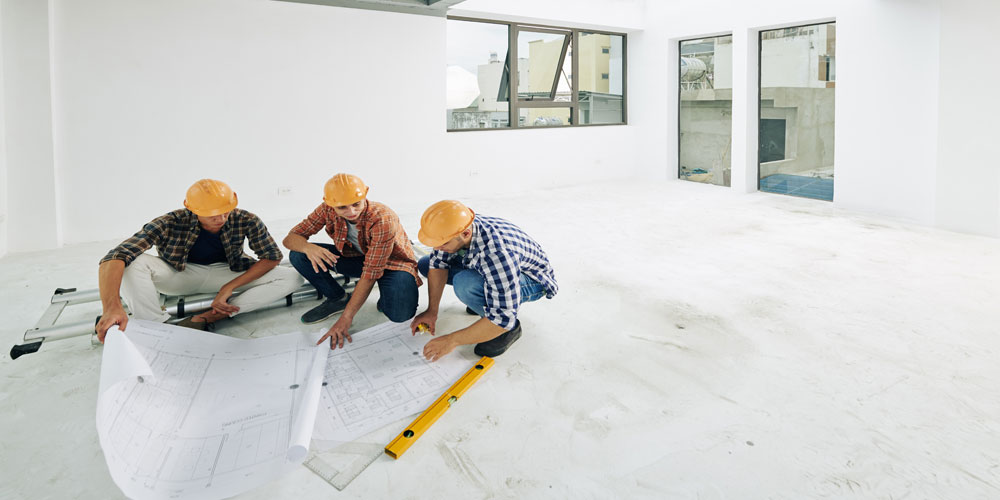
Floor Plenum Testing
Looking at Floor Plenum Testing
A floor plenum is a void between a building’s floor structure and a raised access floor, used for distributing the conditioned air to the spaces above. It is important that conditioned air in a floor plenum flows into the occupied zone and does not leak into cavities, risers, stairwells, heating trenches or other adjacent zones. A properly sealed floor plenum will allow the diffusers and grilles to fulfil their primary role of delivering air at the correct flow rate.
APT Sound Testing undertakes floor plenum testing using a special fan that is set up in the test zone. All air ducts must be turned off and sealed. The test is conducted by taking a series of pressure readings. If the plenum fails the test we can then carry out a smoke survey to highlight the air leakage paths and issue a report for reference during the remedial sealing works.
If you require raised access floor testing, we can arrange a site visit and recommend the tests appropriate for your needs. We will advise you on the most suitable specifications for your structure and we will carry out extensive testing on your floor plenum.
If you want to know more about our plenum floor test services, please contact us today and our expert staff will be happy to advise you further.
In all instances, our strong focus on customer satisfaction, along with a can-do attitude, coupled with the knowledge of a UKAS accredited laboratory, are the key benefits to you when partnering with APT Sound Testing.

What is a Floor Plenum?
A floor plenum is part of a building that normally facilitates air circulation for heating/air conditioning systems by providing pathways for either heated/conditioned or return airflows. The airflow is often supplied at a greater pressure than atmospheric pressure.
Air leakage from floor plenums can be a serious energy efficiency issue and a source of discomfort to users. A floor plenum is a void between a building’s floor structure and a raised access floor, used for distributing the conditioned air to the spaces above. It is important that conditioned air in a floor plenum flows into the occupied zone and does not leak into cavities, risers, stairwells, heating trenches, or other adjacent zones.
It is important that the air supplied to the floor plenum discharges through the floor-mounted diffusers or grilles rather than through joints in the raised access floor or between the raised access floor and the walls. A properly sealed floor plenum will allow the diffusers and grilles to fulfil their primary role of delivering air at the correct flow rate.
What is Floor Plenum Testing?
If you have floor or ceiling plenums in your building you need to be aware that a staggering 70-70% fail their first airtightness test. APT Sound Testing has years of experience of raised access floor plenum air pressure testing and can work with you to ensure you pass your floor plenum air test at the first attempt.
We can ensure that an onsite air test site audit is arranged as soon as the floor is in place; we can then undertake an initial floor plenum air test and smoke survey to check the air leakage result and check for air leakage paths within the plenum envelope. Once we have assessed the air leakage paths we can then supply a smoke survey report for your sealing contractors to use as a reference to ensure your plenums are adequately sealed
Why do so many floor plenums fail their first air test?
There are many reasons why 70-75% of floor plenums fail their first airtightness test. One of the most common reasons is due to a lack of understanding within the construction industry as to how airtight a plenum needs to be. One common problem is that many plenums are built and tested under laboratory conditions; unfortunately, there is a big gap between what happens in a lab to the reality of plenums construction on a building site. With multiple contractors needing to put pipes, cables etc. through the plenum, this is just one of many things that can affect the airtightness of a plenum. APT have years of experience and can work with you to ensure you achieve an air test pass on your plenum at the first attempt.
What happens if we fail the floor plenum test?
A large number of floor plenums fail the initial airtightness test so don’t panic. If we undertake the testing our UKAS accredited air tightness engineers will undertake a targeted smoke survey to highlight the main air leakage paths. We will then issue a smoke survey report for your contactors to reference during the remedial sealing works. We also allow for the option of visiting the site during the sealing works to ensure your contractors are adequately sealing the plenum prior to the second airtightness test. If you would like more information in regards to the most common air leakage paths, please visit our Floor Plenum Checklist.
The main considerations when constructing floor plenums?
In offices, carpet tiles are usually laid over the raised access floor, if joints between carpet tiles are not lined up with the joints between the raised access panel’s floor tiles or panels, the air leakage will be reduced, particularly if the carpet tiles are glued in place. That said, the laying of carpet tiles should not be relied on to achieve the target for the raised access floor itself as these can de-bond over time.
Many raised access floors include electrical and date boxes. The air leakage of these boxes should be ascertained, to ensure that they will not significantly contribute to the raised access floor leakage, and reduce the air flor to the grills or diffusers. Where there are decorative or functional connections through the raised access floor, for example cabling to display boards, a suitable method of air sealing these penetrations should be designed.
The perimeter of the floor plenum where the access floor meets the wall is often an area of increased air leakage. To minimise this leakage it may be beneficial to fix a length of metal angle along the perimeter of the floor. Lengths of closed-cell board or neoprene strips will increase the quality of the seal between the raised floors and the wall and should prevent excess air leakage.
The walls of floor plenums are most vulnerable to air leakage as they are dependent on the type and quality of construction. Plasterboard can be used as the airtightness barrier; however, care should be taken to ensure all joints should be sealed where boards abut other boards, walls, floors and the underside of the raised access floor. This is the same for coated mineral fire boards used in conjunction with fire mastic, the boards should be specified with an air leakage rate of 0.15 l/(s.m2)@50Pa with a life expectancy of at least 25 years.
While poured in-situ concrete floors don’t have any significant air leakage, hollow-core and solid composite precast planks need to be sealed along the plank joints and carefully sealed around service penetrations. Beam and block floors need to be covered by a screed to prevent excess air leakage
How we carry out Plenum Air Tests on your project?
In brief, a temporary tile is removed from the plenum and our fan housing is installed directly above the opening. A fan is then installed into the box and this is all sealed against the floor.
Any air handling ducts serving the test zone need to be turned off, isolated and temporarily sealed, stopping the passage of air to outside of the test zone via ductwork
Thereafter another tile is removed and a mock floor tile with a drill hole for the high-pressure tube is installed in its place.
After the equipment is set up a series of tests is undertake and the readings recorded and then checked against the floor plenum airtightness specification.
If the plenum test fails, your APT air test engineer will carry out a smoke test to look for air leakage paths.
Is there a Standard associated with Floor Plenums Tested?
At present, there is no set standard for floor plenum testing. The specification is usually set by the project’s Mechanical Engineers and is normally set in litres per second per square metre (l/s/m2). APT will need to know what pressure the specification is set at, e.g. 0.7l/s/m2 @ 50 Pascals. It is also possible that the specification can be set in l/s/m3 by the mechanical designers, for this type of test we would require the volume of the Plenum.
What are the most common air leakage paths within floor plenums?
In order to create an effective air-tight floor plenum, all utility penetrations and perimeter joints must be properly sealed. An evaluation of the following areas/components that can typically create inefficiencies should be undertaken during the early design phase and during the onsite construction. For clarity, we have shown the main air leakage paths below.

- Penetrations through the access floor, walls and subfloor including
- Cable bundles and cable trays
- Pipes
- Fire/plenum barriers
- Cable trunking – must be internally sealed within the void
- Masonry work – incomplete or poorly jointed walls will result in greater air leakage
- Risers need to be properly sealed for plenums/ducting
- Plasterboard on studs at board edges and the ends below the raised floor level
- Gaps between compartment barriers, top of raised access floor and sub floor respectively
- Gaps between any curtain walling/glazing
If you are worried about the airtightness integrity of your floor plenum then please contact us now on 01525 303905. or get in touch via our contact form to discuss your specific requirements with our friendly and knowledgeable consultants!